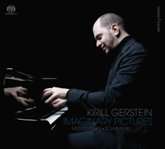|
Back
07/14/2014
Imaginary Pictures
Modest Mussorgsky: Pictures at an Exhibition
Robert Schumann: Carnaval, opus 9
Kirill Gerstein (Piano)
Recording: Funkhaus Berlin Nalepastrasse (November 2013) – 63’08
Myrios Classics # MYR013 – Booklet in English, German and French

   
At quick glance these two works may not appear to have much in common, but Kirill Gerstein will endearingly scrutinize. The talented young Russian pianist, claiming his first award at age 11, is one to closely watch, not only because of his musical prowess, but because of his methodical approach. Mr. Gerstein (having personally written his own liner notes) positions himself on an analytical azimuth, delving back into the composers’ lives…a sort of “living in the moment”...whereby discovering his own imaginary revelations just as Mussorgsky and Schumann would have done while transcribing. Furthermore, Kirill commented, “I looked at the score on the page, some things appeared differently to me than I was used to hearing.” So what are, perhaps, these révélations sur papier?
Turn our attention to 1874 and the Academy of Fine Arts in St. Petersburg, Russia, the venerable showcase housing architect/painter Viktor Hartmann’s works after his sudden death the year before. Hand-picked from the 400+ creations, Mussorgsky created an imaginary musical stroll which, simultaneously, would be Gerstein’s dream development. What’s personally striking are that the expressions translate into a softer, more delicate fashion. The piano retains intimacy, and a certain sense of personalization through a single set of eyes: there is time to breathe, time for privacy, time for human digestion in context of a continuous meandering from painting to painting.
Sometimes the "Promenades” have a bit of abeyance while others rush unexpectedly into another “picture.” The essence of Kirill Gerstein’s success is “putting one’s self in another man’s shoes” and connecting with the sympathetic responses to a wide array of art subjects and details surrounding Hartmann’s pieces. Touches of lyrical finesse stand out as well. For instance, in the “Il vecchio castello”, the interpretation conjures “troubadour” qualities surrounding the stately edifice.
The biased ear will oddly find the “Tuileries” unexpectedly holding back in tempo with cautious rests to attenuate frivolous taunting. In actuality the hesitations heighten the imagery and lighten the chaos enfantin. In stark contrast is the subsequent “Bydlo” that typically plods with lethargy, yet in this rendition the pacing has a bit more inertia and heft, eventually concluding with a pianissimo “largo”…it is lugubrious to the end. Immediately following, the fourth “Promenade” is slower; it allows the viewer to “take in” the immensity and severity of the previous work. This type of sequenced response along with placing importance on forte and piano dynamics makes Gerstein’s Pictures at an Exhibition a realistic, rarified journey. Many other examples can be found within, but leave that venture for the listener to discover on his/her own.
Content-wise, much of what we hear in Robert Schumann’s Carnaval can be indirectly accredited to père August Schumann who was a novelist, publisher and bookseller. This literary/cultural foundation was the igniting spark plug of something extraordinary inside the dissection of musical construct. Robert Schumann must have regaled in formulations of cryptogram derivatives that would allow future pianists to contemplate, extract and replicate the desired intentions of this Romantic Era composer. This piece is also appropriately subtitled, Scènes mignonnes sur quatre notes (Little Scenes on Four Notes) which is the premise for all 21 movements. Just as Modest immersed himself in pictures, Robert indulged in characterizations, both fictional and non-fictional, drawing from past historians (i.e. Eusebius), the commedia dell’arte (i.e. Pantalone, Colombine, Pierrot, Arlequin), contemporaries (i.e. Paganini, Chopin), personal loves (i.e. Chiarina, Estrella) as well as machinations from his quasi make-believe Davidsbündler.
Depicting personae found at a masked ball, the musical vignettes appear and disappear in the blink of an eye. The flights of fancy keep coming, and Gerstein places himself inside Schumann’s head to discern the boundary crossings between realms of fantasy and bona fide flesh and blood. An admirer of Frédéric Chopin, several of Robert Schumann’s sketches exude similar charm and serenity, but the dramatic (i.e. “Chiarina”), quirky (i.e. “Valse allemande”) and foppish (i.e. “Coquette”) adjectives can justly describe some of the many emotional facets fluttering from page to page. Kirill Gerstein can be widely credited with lovely undulations and hesitant clauses in order to particularly capture the multitudinous flavors of masquerades parading into a pre-Lent revelry.
Substantive qualities resonate through the dexterity of Mr. Gerstein. His interpretation is the key to this successful Myrios Classics’ recording. Thought-provoking processes are energized to question how Mussorgsky and Schumann must have felt deep down when trying to convey their inner most feelings to the public by way of imagery.
Christie Grimstad
|